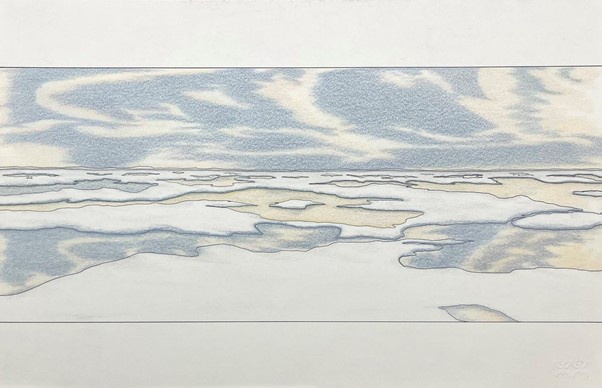
Ooloosie Saila, Long Landscape, 2018. Coloured pencil on paper, 30 x 92 in. Dorset Fine Arts
The project From the Floe Edge: Visualising Local Sea Ice Change in Kinngait, Nunavut engages with art history, visual studies, scientific analyses, and local knowledge to better understand the relationship between the community and artists in Kinngait with and surrounding sea ice change.
From the Floe Edge is funded (2024-26) through a British Academy Knowledge Frontiers International Interdisciplinary Research Project (KF8/230008) in collaboration with the West Baffin Co-operative and Duke University.




About the project

Padloo Samayualie, Spring (2018), coloured pencil and ink on paper, 38 x 58.5 cm. Dorset Fine Arts.
For many Arctic communities and ecosystems, one of the most impactful consequences of climate warming is the deterioration of coastal sea ice which forms along its coastline during winter and spring. This coastal sea ice or siku, is of immense importance to Arctic communities, as it provides a crucial marine mammal and seabird habitat, is used extensively for travelling between otherwise isolated communities, and provides a key platform for subsistence hunting and fishing. The experience of coastal sea ice and the floe edge, or sinaaq, is also inherently very local. Ice edge formation and breakup can be widely variable from year to year, and its patterns at the local scale are largely uncorrelated with the sea ice that forms in the open ocean. Increasingly, the floe edge is getting closer to land, the quality and thickness of the ice is declining, and the length of the ice season is decreasing. Around the Circumpolar North, sea ice has been and remains a recurring motif in art history and contemporary visual culture. For Inuit artists, sea ice is closely interconnected with social and cultural identity. Not only is the frozen shore visible from the Kinngait Studio windows within the Kenojuak Community Centre, but the artist's own experiences of the sea ice, many as hunters, extends into the picture plane.


L-R - Kenojuak Community Centre, Feb 2023. View from Kenojuak Community Centre, Feb 2023. , Photos by Isabelle Gapp
Using printmaking and drawing, alongside satellite observation and sea ice data, From the Floe Edge examines the stories, science, and visual histories of the cryosphere by working across art history and glaciology, and in collaboration with Inuit artists in Kinngait. Through conversations and collaborations with local artists, hunters, and residents, who are inspired by and rely upon the sea ice, we propose an interdisciplinary, community-led, visually-oriented study of the sea ice and floe edge surrounding Kinngait to explore how, and if, our tools, visual and scientific might be used to understand and re-imagine our past, present, and future relationships with the sea and the cryosphere.
Project Team
- Dr Isabelle Gapp
-

- Dr Sarah Cooley
-

- The Kinngait Studios
-

News and Events
- Latest News
-
There is no latest news.
- Upcoming Events
-
There are currently no upcoming events.
Subscribe to our RSS feed to stay up-to-date with upcoming events.
- Blog Posts
-
There are no Blog posts to display.
